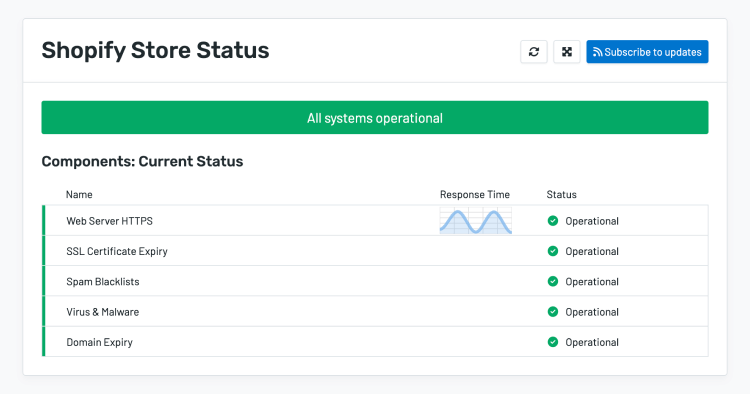
Website Monitoring for Shopify: Avoid Downtime & Lost Revenue
In today’s fast-paced e-commerce world, it’s essential for your Shopify store to remain accessible and functional at all times.
Even a brief period of downtime can result in substantial lost revenue, tarnish your brand reputation, and drive potential customers to your competitors.
That’s why website monitoring for Shopify should be an indispensable component of your store’s digital infrastructure.
Why Uptime Monitoring is Essential for Your Shopify Store
- Customer Satisfaction and Retention: Downtime can lead to lost sales and frustrated customers. By monitoring your Shopify store’s uptime, you can address issues promptly and minimize the impact on your customers.
- Improved Search Engine Rankings: Consistent uptime contributes to better search engine rankings, as search engines tend to penalize sites with frequent downtime.
- Protecting Your Online Reputation: Prolonged website downtime can harm your brand image and lead to negative customer reviews. Monitoring helps you safeguard your reputation.
Key Features You Need
An ideal uptime monitoring solution for your store should offer the following features:
- Real-Time Monitoring: Constant monitoring enables you to detect and resolve issues quickly, minimizing downtime.
- Automatic Alerts: Receive instant notifications via email or text message when your website experiences downtime, allowing you to take swift action.
- Detailed Reporting: Regular reports provide insights into your website’s performance, helping you identify trends and areas for improvement.
- Global Monitoring: Ensure that your Shopify store is accessible worldwide with monitoring from multiple locations.
How to Set Up Monitoring for Your Store
- Choose a Monitoring Tool: Research and select an uptime monitoring tool that best meets your Shopify store’s needs and budget.
- Create an Account: Sign up for the monitoring service and follow the provider’s instructions to set up your account.
- Configure Monitoring Settings: Enter your Shopify store’s URL, select monitoring frequency, and choose global monitoring locations if available.
- Set Up Alerts: Customize alert settings, specifying how you want to be notified of any downtime (email, SMS, or app notifications).
- Review Reports and Optimize: Regularly review the reports generated by your monitoring tool to identify trends and make necessary improvements to your Shopify store’s performance.
Top Uptime Monitoring Tools to Consider
Several uptime monitoring tools are well-suited for Shopify store owners. Some of the most popular options include:
- Uptime.com: A powerful monitoring platform with a robust feature set, including basic monitoring, synthetic transaction monitoring, and real user monitoring. Get global coverage from 30+ locations across 6 continents. Receive accurate, real-time alerts when your website goes down.
- Pingdom: A well-known monitoring service that offers real-time monitoring, alerts, and in-depth reporting.
- UptimeRobot: A simple and affordable solution that provides global monitoring and customizable alert settings.
- Site24x7: A comprehensive monitoring tool with features like synthetic transaction monitoring and infrastructure monitoring.
- StatusCake: A user-friendly service that offers detailed reporting, custom alert options, and multi-location monitoring.
Minute-by-minute Uptime checks.
Start your 14-day free trial with no credit card required at Uptime.com.
 Uptime.com Blog
Uptime.com Blog


